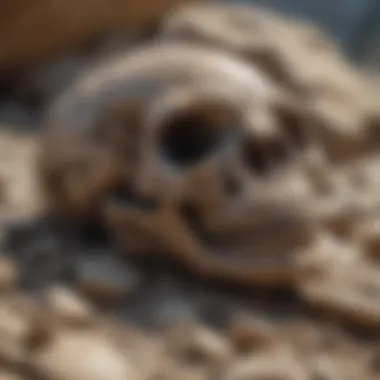Exploring California's Fossils: A Timeless Journey


Intro
California is a treasure trove for those curious about our planet's distant past. The fossil landscape here is not just a window into history; it's a mosaic of stories that reveal how life evolved and adapted over millions of years. With each fossil serving as a tiny time capsule, one can glean insights that are far richer than mere dates and geological layers. Collectors—both amateur and professional—find that the thrill of discovery and the pursuit of knowledge goes hand in hand in this captivating field.
History and Origins
The journey through California’s fossil history begins millions of years ago, when much of the state's terrain was ocean floor. This marine environment preserved a plethora of organisms, which, through the art of fossilization, have been preserved for future generations to uncover. Fossilized remains found across California—ranging from the iconic mammoths at the La Brea Tar Pits to microscopic organisms in sedimentary rocks—shed light on a rich evolutionary tale.
Overview of Collectibles, Rocks, and Fossils
Collectors often seek out specific types of fossils, each with its unique story. For example, those interested in mesozoic critters may find their joy in collecting dinosaur bones or marine reptiles, whereas others may lean toward more mundane yet equally fascinating fossils like leaf imprints or insect encasements in amber. Commonly found fossils here might include:
- Ammonites: Shells that swirl in intricate patterns.
- Coprolites: Fossilized dung that tells us about ancient diets.
- Trilobites: Once abundant arthropods, now mere remnants of their past.
These collectibles not only hold scientific value but also connect individuals to a long-gone world, making their preservation essential.
Historical Significance and Cultural Impact
California’s fossil beds are steeped in tales of discovery and cultural significance. From the time of early Native American peoples, who often viewed fossils as relics of great herds extinguished in some unknown past, to the more recent scientific expeditions, the state has a profound fossil narrative.
The La Brea Tar Pits, for instance, aren't just a fossil site; they have become a cultural landmark. Here, the Los Angeles County Museum of Natural History sends excavators to retrieve bones of mammals that roamed the Earth over 10,000 years ago. The implications are vast, touching on themes of extinction, survival, and what connects humans to the creatures that once thrived here.
Identification and Classification
Identifying and classifying fossils is an art and a science. Whether you are sifting through ancient soil or examining rocks, having a keen eye can transform what seems like a mundane piece of stone into a history-laden artifact.
Guide to Identifying Rocks and Fossils
For those starting their journey into paleontology, a few key characteristics can help in the identification process:
- Texture: Is the surface smooth, rough, or layered?
- Color: What shades does it wear? Some fossils exhibit vibrant hues due to mineral replacement.
- Shape: Does it resemble a bone, shell, or perhaps a leaf?
Understanding these elements aids collectors in distinguishing between rocks and genuine fossils. Utilizing tools like a hand lens or field guide can greatly enhance the excavation experience.
Common Types and Variations
The variety of fossils that can be discovered is astonishing. Common fossil types in California include, but are not limited to:
- Bone fossils: Remains of large mammals and dinosaurs.
- Shell fossils: Featuring everything from tiny bivalves to larger sea creatures.
- Plant fossils: Leaves or wood preserved in a striking detail that can tell ecological tales.
California’s dynamic geology contributes to a rich assortment of fossil types that can be enthusiastically pursued by collectors. In this land of sun and stone, each fossil unearthing can provide a new clue to our planet's history, connecting present to the past in an intricate dance of discovery.
Preamble to California's Fossil Record
The study of fossils provides significant insight into the history of life on Earth. California, a state rich in diversity, hosts a fossil record that tells tales of ancient ecosystems and the evolution of species over millions of years. Understanding this record not only satisfies curiosity about the past but also informs current scientific inquiries, offering answers to questions about climate change, biodiversity, and extinction.
The Importance of Fossils
Fossils serve as crucial evidence of historical life forms and ecological conditions. They offer a window into environments long gone, helping scientists reconstruct ancient climates and ecosystems. In California, fossils range from the remains of massive mammals roaming its plains to tiny marine organisms that once thrived in what are now dry desert expanses. This variety portrays a dynamic landscape influenced by shifting geological and climatic conditions.
Fossils also play a pivotal role in education and public engagement. Museums, like the California Academy of Sciences, present fossil displays that captivate the imagination, bridging gaps between scientific understanding and public interest. Through such exhibits, individuals can appreciate the heritage of life and the ongoing processes that shape our planet.
"Fossils are the keys that unlock the stories of our planet's history."
California's Unique Geological Features
California's geology is a tapestry of varied landscapes, each contributing uniquely to its fossil record. The California coast features sedimentary formations rich in marine fossils, remnants of ancient seas. Moving inland, the Sierra Nevada mountains present an entirely different profile, with fossils indicating the presence of once-thriving rainforest ecosystems.
The state’s tectonic activity has also sculpted its geological narrative. The San Andreas Fault and surrounding areas reveal layers of sediment that have been pushed up over time, allowing access to fossils from different epochs. These geological features make California an exceptional area for paleontological research, each site revealing layers of history that contextualize life across ages.
In summary, California's fossil record not only highlights the intricate dance of life throughout history but also emphasizes the relationship between geological changes and fossilization processes. As both a treasure trove for collectors and a fundamental aspect of scientific research, understanding California's fossil landscape proves essential for unraveling the complexities of Earth’s biological past.
Key Fossil Sites in California


California's fossil landscape is a treasure trove, revealing a diverse array of specimens that not only contribute to our understanding of prehistoric life but also expose the state’s geological evolution over millions of years. As we traverse these key fossil sites, we not only uncover rich deposits but also the stories they tell about the environments that once thrived here. This section focuses on California’s most notable fossil locations, emphasizing their significance and the unique insights they offer into the distant past.
La Brea Tar Pits: A Fascinating Snapshot
The La Brea Tar Pits, located in the heart of Los Angeles, are a captivating study in contrasts. Nestled among modern skyscrapers, this site gives us a peek into the life of the Pleistocene era. Created from natural asphalt seeping onto the surface, the tar pits have been a veritable gold mine for paleontologists since the late 19th century.
What makes La Brea particularly intriguing is the sheer volume and variety of fossils found within the sticky asphalt. From saber-toothed cats and mammoths to an array of smaller creatures, the tar pits captured them all, preserving their bones in a relatively unchanged state. This unique preservation has allowed scientists to study these creatures' morphology, behavior, and even their last meals.
“The La Brea Tar Pits provide us with a snapshot frozen in time, showcasing a rich tapestry of life and an intriguing context for the evolution of various species.”
Hazarding a look at its significance, it provides critical data for understanding extinct ecosystems. With ongoing excavations, La Brea continues to unveil new discoveries, each with the potential to change our understanding of the past.
The Fossil Beds of the Central Valley
Traveling inland, the Central Valley emerges as another vital fossil site. Known for its fertile agricultural lands today, this region was once submerged under vast oceans. The fossil beds here tell tales of marine life that flourished millions of years ago.
Notably, the sediments contain a wealth of marine fossils ranging from mollusks to ancient whales. These remnants present invaluable clues to paleoenvironments, including the climatic conditions and ecological interactions of the time. As researchers sift through layers of sediment, they piece together a narrative of changing sea levels, temperatures, and biodiversity shifts over eons.
Sample finds include well-preserved shells and vertebrate remains, each of which builds a picture of the ecosystem that existed before extensive tectonic shifts changed the landscape. This intersection of geology and biology highlights how California’s terrain has morphed over millennia—a theme echoed across its fossil record.
Channel Islands: Remote Treasures
The Channel Islands, a remote archipelago off the Southern California coast, are often overlooked in discussions about significant fossil sites. Despite their isolation, these islands harbor unique fossil deposits that provide insights into endemic species and adaptations.
Fossils discovered here include those of small mammals, like the diminutive Channel Island fox and ancient pygmy elephants that once roamed these lands. The limited geographical scope of the islands allowed evolution to take its course in unexpected ways, resulting in species that diverged significantly from their mainland counterparts.
Researchers have found that the fossils and associated geological layers reveal stories of changing climates and habitats. These islands emphasize the importance of isolattion in evolutionary processes and highlight how environmental pressures can shape organisms in localized settings.
In summary, the Channel Islands stand as a testament to California’s biodiversity, offering a lens through which we can understand evolution amidst isolation.
Through these key fossil sites, California provides a rich narrative of life through the ages—an intricate web of ecosystems, climatic changes, and evolutionary marvels that continue to inform our understanding of Earth’s history.
Types of Fossils Found in California
The exploration of California's fossil record leads one to a myriad of discoveries, each hinting at the rich tapestry of life that once thrived in this state. Understanding the types of fossils found here isn't just about the past; it's a glimpse into the ecological shifts that sculpted the land. Fossils can reveal the story of ancient climates, ecosystems, and the creatures that walked this varied terrain. With sites like La Brea, the fossil landscape ranges broadly from marine depths to terrestrial giants, each telling a unique tale.
Marine Fossils: Evidence of Ancient Seas
California's coast tells a story where the ocean once lapped against the land far beyond today's shoreline. When researching marine fossils, one can unearth evidence of ancient mollusks, vertebrates, and corals, revealing past marine ecosystems. For example, the Miocene Epoch left behind fossils of sea creatures like the now-extinct Squalodontidae, a type of predatory dolphin, and the Megalodon, an enormous shark that ruled the seas.
Marine fossils provide insight into how changing sea levels and climate transitions influenced marine biodiversity. When the regions north and south of California were part of the subtropical marine environment, these creatures thrived, adapting and evolving in ways that fascinate scientists today.
Terrestrial Fossils: Giants of the Past
Shift gears from the depths of the ocean to the land, and one will discover giants that once roamed California. Terrestrial fossils offer a glimpse into a time when colossal creatures could be spotted across the landscape. Among the most remarkable finds include the remains of Mammoths, Saber-toothed Cats, and Giant Ground Sloths. These fossils, scattered across various sites including the Sierra Nevada and the Central Valley, are invaluable to scientists.
The presence of these large mammals not only speaks to the biodiversity of the time but also hints at evolving ecosystems. Fossils found in California indicate how these creatures came to dominate the landscape. As environments shifted from colder to warmer, animals adapted or went extinct, shaping the dynamics of life as we know it today.
Extinct Species and Their Significance
The extinction of species teaches us about resilience and vulnerability in ecosystems. California’s fossil finds include species like Paraceratherium, a massive hornless rhinoceros, and Neotropical crocodiles. These fossils provide evidence of how ecosystems are delicate balances that can be tipped over time.
Studying extinct species offers critical insight into the conditions that led to their disappearance. Learning how past climates influenced extinction events or how human activity reshaped habitats reinforces the importance of conservation today.
It's crucial to recognize that every fossil is a fragment of our planet's history. They serve as a testament to the great narrative of life on Earth and should be treated with the respect they deserve. Understanding extinct species enhances our comprehension of biodiversity and the potential threats facing current species.
"Fossils are windows into the past, providing key insights into life and environments that once flourished on Earth."
Fossilization Process: How Fossils Are Formed
Understanding the fossilization process is fundamental to appreciating California's rich fossil heritage. Fossils serve as windows into the past, allowing scientists and enthusiasts alike to glimpse ancient ecosystems and the organisms that inhabited them. This section will delve into the mechanisms through which fossils are formed, focusing on sedimentation and mineralization, the two key processes that transform organic remains into lasting geological records.
The Role of Sedimentation


Sedimentation is a crucial player in the fossilization game. It begins with the accumulation of layers of sediment—such as mud, sand, and silt—often found in riverbeds or ocean floors. As these layers build up over time, they create pressure on the underlying sediments and any organic material trapped within. This pressure is essential; it gradually compresses the organic remains, slowing down their decay and providing favorable conditions for fossilization.
One of the interesting aspects of sedimentation is its ability to protect remains from scavengers. When an organism dies, if it's quickly buried under layers of sediment, it is shielded from the elements, thus increasing the chances of fossil preservation. In California, places like the Central Valley embody these sedimentary processes. The sedimentation rate can provide not just fossils but also insights into the environmental conditions at the time of deposition.
Furthermore, sediment types matter. For example, fine sediments tend to preserve delicate features better than coarse sediments. In the context of California, the variety of sediments found across regions is indicative of ancient environments, be they lakes, rivers, or oceans. This diverse sedimentation helps explain the array of fossils discovered throughout the state.
Mineralization Techniques
Once an organism is buried and sedimentation occurs, the next step in the fossilization process involves mineralization. This is where the magic truly happens. During mineralization, the organic materials within the remains slowly dissolve and are replaced by minerals from the surrounding sediment. Think of it as mother nature's way of turning a once living creature into a stone-like replica of itself.
This process can take thousands to millions of years, depending on environmental factors. For instance, water rich in minerals seeps into the remains, gradually transforming them into a solid fossil. The most common minerals involved are silica, calcite, and pyrite, each contributing distinct characteristics to the final fossil.
An important point to note is that mineralization is not uniform. Different materials and environments yield different fossil types. For example, the petrified forest in Calaveras County showcases how wood can become mineralized and turn into stunning specimens over time. This aspect captures the ongoing dance between the organic and inorganic worlds, making each fossil a unique artifact of our planet’s history.
"Fossils are as much about the stories they tell as they are about the entities themselves. They bridge the gap between today and eons past."
In summary, sedimentation and mineralization are the twin pillars of fossil formation, each playing a vital role in this intricate process. By understanding how fossils are formed, rock and fossil collectors can better appreciate the significance of their finds, recognizing that each piece holds a story that traces back through millions of years of geological history.
Paleontological Techniques in California
Paleontological techniques play a critical role in the study of California's vast fossil record. These methods are the keystone of understanding not only where fossils lie but also how they formed, what they can tell us about past life, and even how we can best preserve them for future generations. This section will dive into both the fieldwork approaches and laboratory techniques that paleontologists employ in California, highlighting their benefits and the unique challenges they face in these endeavors.
Fieldwork: Methods and Challenges
Fieldwork is the backbone of paleontological exploration. It involves the actual process of searching for fossils in the natural environment. In California, researchers often traverse diverse terrains, from the rugged cliffs of the Channel Islands to the vast expanses of the Central Valley. Here are some essential methods utilized in the field:
- Site Identification: Before any digging begins, paleontologists must identify potential fossil sites. This often involves studying geological maps and previous fossil findings. California's varied geology provides a plethora of promising locations.
- Excavation Techniques: Once a site is selected, careful excavation is necessary. This might mean using hand tools like trowels and brushes, or larger equipment, depending on the site's size and fragility. It’s imperative to work with caution to avoid damaging potential fossils lying just beneath the surface.
- Documentation: Data collection during fieldwork is vital. Detailed notes, photographs, and maps are made to ensure that the context of the finds is preserved. Every detail counts—what's found, where it's found, and how it's related to other geological features.
“Each fossil tell a story, but only if you understand the context in which it was found.”
However, California's unique landscape presents challenges:
- Environmental Factors: Weather can be unpredictable. Rain can erode sites, while extreme heat can make work uncomfortable. Planning around these variables is essential for success.
- Legal and Ethical Concerns: In certain areas, like state parks, specific regulations govern fossil collection. Understanding these laws is critical for responsible fieldwork.
Laboratory Techniques: Preservation and Analysis
After fossils are carefully excavated, they require meticulous analysis and preservation. The laboratory component is where the real detective work begins. Here's a look at the techniques commonly employed:
- Cleaning and Preparation: Fossils often arrive in a rough state, encapsulated in rock or sediment. Techniques such as air abrasion, chemical treatment, and manual excavation help in revealing the fossil’s true form. Each method carries risks, as inappropriate cleaning can damage brittle specimens.
- Morphometric Analysis: Once cleaned, paleontologists may use sophisticated measuring tools to analyze the fossil's shape and structure. Using digital calipers, 3D scanning, or even CT scanning, they can gather quantitative data essential for classification and understanding functional morphology.
- Dating Techniques: Establishing a fossil’s age is crucial for contextualizing findings. Both relative dating (like stratigraphy) and absolute dating techniques (like radiometric dating) are employed to frame where a specimen lies in the timeline of life on Earth.
In considering the future of paleontology in California, these methods must stay innovative and adaptive. As science and technology evolve, so too does the necessity for paleontological techniques to keep pace, ensuring that the wealth of knowledge embedded in California's fossil record is preserved and understood for generations to come.
The Intersection of Collecting and Preservation
The world of paleontology in California is not just about the thrill of discovery; it's also deeply entwined with ethics and responsibility. As rock and fossil collectors unearth the remnants of ancient life, they face questions that shape the future of our planet's historical narrative. The conservation of these delicate artifacts is paramount, touching upon various aspects like the legal implications of collection and the moral duties that collectors have towards the environment and science.
Ethical Considerations in Fossil Collection
Collecting fossils involves striking a balance between the pursuit of knowledge and the necessity of preserving natural history. While collectors often act with the best intentions, several ethical considerations must guide their actions.
- Legal Workflow: Understanding the legal framework surrounding fossil collection is crucial. Some states have strict laws that protect fossil sites from unauthorized digging. Know where to collect, and acquire the necessary permits to keep things above board.
- Protection of Ecosystems: When digging in sensitive areas, collectors must consider the surrounding ecosystem. Disturbing habitats can have far-reaching consequences for local fauna and flora. Collectors should strive to minimize their impact.
- Sharing Knowledge: Ideally, fossil collectors should share their findings with the wider scientific community. By doing this, they'll contribute to further research and education, enriching the body of knowledge about ancient life.
By following these ethical guidelines, collectors can ensure that their passion does not come at the cost of future scientific exploration.
Museums and Their Role in Conservation
Museums are the gatekeepers of natural heritage, serving as both protectors and educators in the realm of paleontology. Their role extends beyond merely displaying fossils; they are instrumental in the conservation and study of these ancient specimens.
- Storage and Care: Museums possess specialized facilities that maintain optimal conditions for fossil preservation. These institutions often invest in climate-controlled environments to prevent deterioration, ensuring that these treasures remain intact for future generations.
- Research Opportunities: Museums facilitate collaboration among scientists, offering a platform for ongoing research. Fossils that may appear mundane in a collector’s display can hold significant value when examined in a research context, leading to new discoveries and insights about Earth's past.
- Public Engagement: Museums educate the public through exhibitions and outreach programs. These initiatives often inspire new generations of paleontologists and inspire a love for both science and history.
Fossils serve as a connection to a time long gone. Thus, museums play an essential role, bridging the past and the present, sustaining California's rich paleontological heritage.
"The stories told by fossils underpin our understanding of Earth’s biological history and inform the current state of biodiversity."


Through the intertwining of collecting and preservation, both collectors and museums contribute to the legacy of the Earth, crafting an ongoing dialogue about what it means to understand our natural world.
Collaborative Efforts in California's Fossil Community
Collaborative efforts in California's fossil community are crucial for fostering research and preserving the state's paleontological treasures. These partnerships not only enhance the scientific knowledge surrounding fossils but also promote the ethical collection and conservation of these invaluable specimens. As we explore the interconnections between researchers, collectors, and institutions, it becomes clear how essential collaboration is in advancing Florida’s fossil understanding.
Partnerships Between Researchers and Collectors
The relationship between academic researchers and amateur fossil collectors in California has flourished over the years. Many amateur fossil hunters possess an intimate understanding of their local geology that can inform scientific studies. Conversely, researchers often bring expertise and resources that can help to validate the significance of such finds.
For example, an amateur collector may discover a rare bone in the hills of San Diego. If this collector reaches out to a local university or museum, a formal partnership can form. The researchers can conduct further studies, often bringing funding and technical knowledge, while the collector receives recognition for their find, which adds great value to the scientific community.
Additionally, training sessions or seminars can go a long way. Researchers often host workshops to teach collectors about proper excavation methods, fossil preparation, and the significance behind what they find. These events foster trust and ensure that everyone is working towards a common goal: the preservation and understanding of California's remarkable fossil record.
Public Engagement and Education Initiatives
Public engagement and education are vital components of California's fossil community. These efforts aim to inform and inspire the next generation of paleontologists and fossil enthusiasts. Numerous museums and educational institutions across the state offer programs that allow the public to connect with California's rich geological history.
Visitors to places like the Natural History Museum of Los Angeles often have the chance to participate in hands-on fossil workshops. Such programs reinforce the importance of fossils, making the subject accessible and enjoyable. Schools often partner with museums for field trips, where students can see real fossils and learn about their formation and history in a tangible way.
Moreover, collaborative educational initiatives can promote awareness about the ethical dimensions of fossil collecting. Teaching both young and seasoned enthusiasts about sustainable practices ensures that California's fossil heritage is respected. The use of social media platforms, like Facebook and Reddit, allows community members to share insights and resources, furthering public knowledge and promoting responsible fossil collecting.
"A strong community enriches fossil studies; the blends of ideas and knowledge paint a fuller picture of our planet’s history."
From engaging young minds to fostering cooperation between knowledgeable collectors and dedicated researchers, the work being done in California’s fossil community underscores the importance of collaboration. These efforts not only elevate our understanding of fossils but also ensure that fossils continue to be a source of fascination and education for generations to come.
Future Directions in California Paleontology
Paleontology isn’t just a dusty old science; it’s a dynamic field continually reshaped by new discoveries and evolving methodologies. California, with its treasure trove of fossils, stands at the forefront of this evolving narrative. The future of paleontology in this state is not only about unearthing more fossils but interpreting them through innovative lenses. As we look ahead, we see several emerging research areas and technological advances that promise to deepen our understanding of ancient ecosystems.
Emerging Research Areas
There’s a growing interest in the intersection of climate change and paleontology. Researchers are looking at how ancient species responded to shifts in climate millions of years ago. This can offer insights into how current species might fare in a rapidly changing world. A prime example comes from studies on marine fossils off the Californian coast, where scientists are investigating the legacy of temperature fluctuations on ancient sea creatures.
Additionally, microfossils are being scrutinized more carefully. These tiny remnants can tell stories that larger fossils may gloss over. By examining these small—but not insignificant—fossils, paleontologists can piece together intricate food webs and ecological changes over time.
Collaboration across disciplines is also becoming a driving force in research. Scientists are increasingly teaming up with ecologists, geologists, and even geneticists to build a more comprehensive picture of how life once thrived in California. Such interdisciplinary approaches allow for multifaceted research paradigms that lead to richer understandings of fossil evidence.
Technological Innovations in Fossil Study
Tech is making ripples in many waters, including paleontology. One notable innovation is the utilization of 3D scanning and modeling. These techniques allow researchers to create accurate digital representations of fossils. Not only does this facilitate preservation but it also aids in research accessibility. Fossil scans can be shared globally for collaborative study without risking damage to the original specimens.
Moreover, advancements in geochemical analysis have opened doors to understanding the environments that shaped these fossils. Scientists can now conduct detailed elemental compositions on fossilized remains, shedding light on the diets, habitats, and even the behaviors of ancient organisms. Imagine revealing intricate details about the life of a long-extinct creature by analyzing just a small fragment of its bone!
"As technology evolves, so too do our questions and methods — the future of paleontology is bright with possibility."
Finally, artificial intelligence and machine learning are beginning to play roles traditionally reserved for human researchers. These technologies can sift through vast datasets of fossils and identify patterns that might escape notice otherwise. AI could potentially streamline the classification of new finds, quickly matching them with existing categories based on features rather than requiring prolonged manual review.
As we march forward, the synergy between innovative research areas and cutting-edge technology in California’s paleontological community suggests that the next steps in our understanding of the past might not only illuminate bygone eras but also inform our future decisions concerning biodiversity and conservation.
Ending: Understanding Our Natural Heritage
As we reach the end of this exploration into California's fossil record, it becomes clear that understanding fossils provides us with a window into our planet's past. Fossils are not just remnants of ancient life; they tell a story of evolution, extinction, and adaptation over millions of years. For collectors and enthusiasts alike, engaging with these remnants offers a deeper connection to the Earth and its history.
The Value of Fossils in Earth Science
Fossils are the silent witnesses of life's history. They help scientists uncover not just who lived in ancient environments, but also how these ecosystems functioned. Understanding the layers of sedimentary rock where fossils are found allows researchers to interpret past climate conditions and ecological shifts. By studying fossils, we can:
- Assess biodiversity: Fossils provide a record of species diversity over time, revealing patterns of life and extinction that help us predict future ecological outcomes.
- Track climatic changes: Analyzing the types of fossils found in different geological strata helps understand historical climate variations and their effects on species survival.
- Inform conservation efforts: Insights gained from fossils can guide conservation strategies for modern species, especially those facing threats from climate change and habitat loss.
"Fossils act as nature's time machine, allowing us to revisit epochs gone by and learn from them."
Encouraging Future Generations of Paleontologists
Instilling a passion for paleontology in the younger generation is vital. Encouraging curiosity about fossils and ancient life fosters a new wave of talent ready to tackle future challenges in science and conservation. Here’s how we can nurture this interest:
- Educational programs: Schools can enhance science curricula with hands-on fossil study or field trips to local fossil sites, making learning interactive and tangible.
- Community engagement: Local fossil clubs and online forums can provide platforms for enthusiasts to share knowledge and discoveries, enhancing community spirit. Online discussion places like reddit.com offer excellent opportunities for budding paleontologists to ask questions and learn.
- Inspiration through discoveries: Showcasing significant fossil finds, like those at the La Brea Tar Pits, can light a spark in young minds, illustrating the exciting world of paleontology.
As we reflect on California's rich fossil heritage, we acknowledge it as a tapestry of life that continues to shape our understanding of the natural world. By valuing these remnants, we not only pay homage to the past but also lay the groundwork for future scientific inquiry and conservation efforts.



